HST5120 - Critical Analysis of E-Cigarette Impact on Public Health
VerifiedAdded on 2023/06/03
|12
|2802
|217
Report
AI Summary
This report provides a critical analysis of the public health issue surrounding e-cigarette use and its impact on smoking rates and overall health. The analysis evaluates various studies, examining the effects of e-cigarettes on consumers and the general population, considering factors such as regulations, potential benefits for smokers, and adverse health impacts. The report explores conflicting viewpoints regarding the safety of e-cigarettes compared to traditional cigarettes, with some studies suggesting they are a safer alternative while others highlight potential risks like nicotine addiction and long-term health issues. The methodology and data collection methods of the reviewed studies are also critically assessed, and the report concludes that further research is needed to fully understand the long-term effects of e-cigarette use and to inform public health policies effectively. Desklib provides a platform for students to access this and other solved assignments to aid in their studies.

Public Health 1
RUNNING HEAD: PUBLIC HEALTH
Public Health Issue
RUNNING HEAD: PUBLIC HEALTH
Public Health Issue
Paraphrase This Document
Need a fresh take? Get an instant paraphrase of this document with our AI Paraphraser
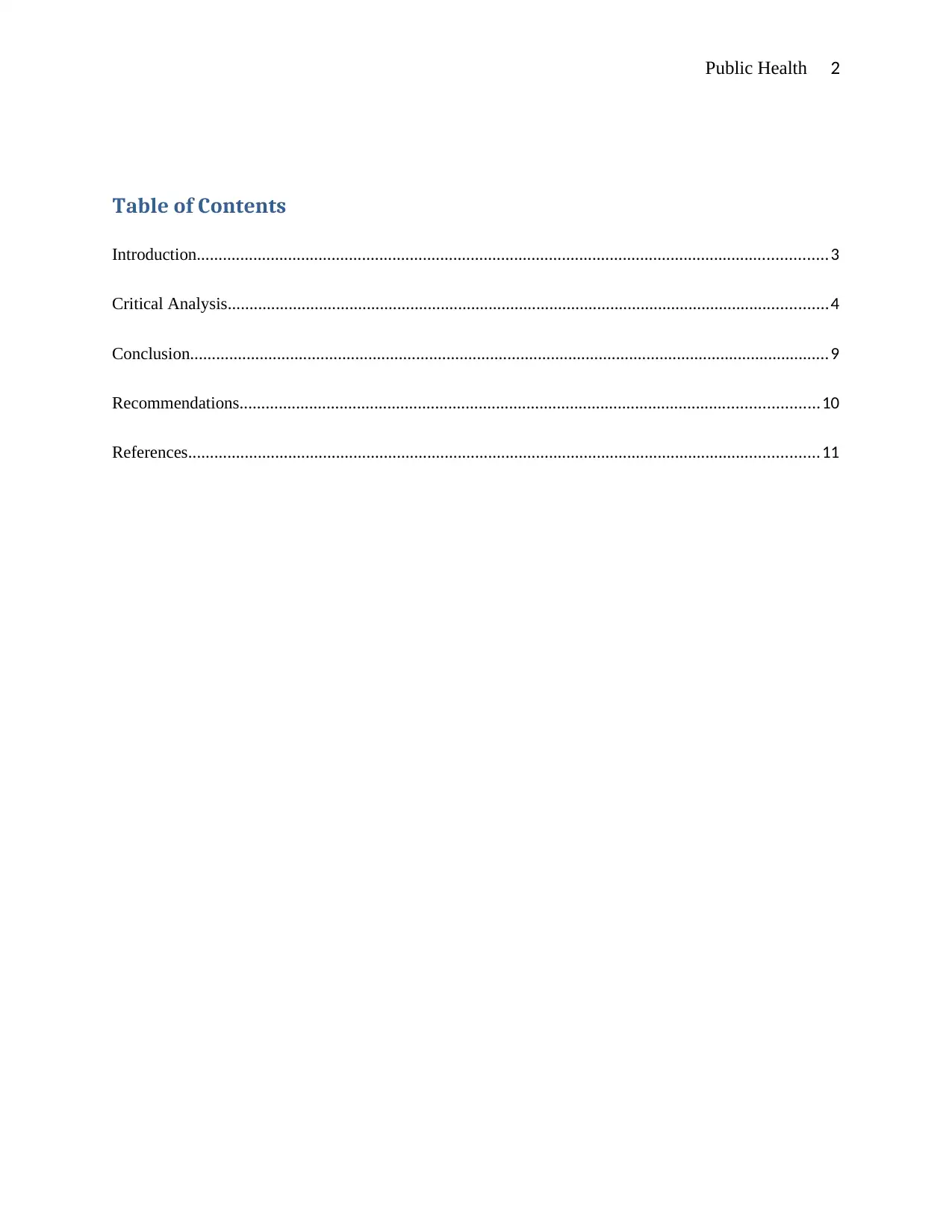
Public Health 2
Table of Contents
Introduction.................................................................................................................................................3
Critical Analysis..........................................................................................................................................4
Conclusion...................................................................................................................................................9
Recommendations.....................................................................................................................................10
References.................................................................................................................................................11
Table of Contents
Introduction.................................................................................................................................................3
Critical Analysis..........................................................................................................................................4
Conclusion...................................................................................................................................................9
Recommendations.....................................................................................................................................10
References.................................................................................................................................................11
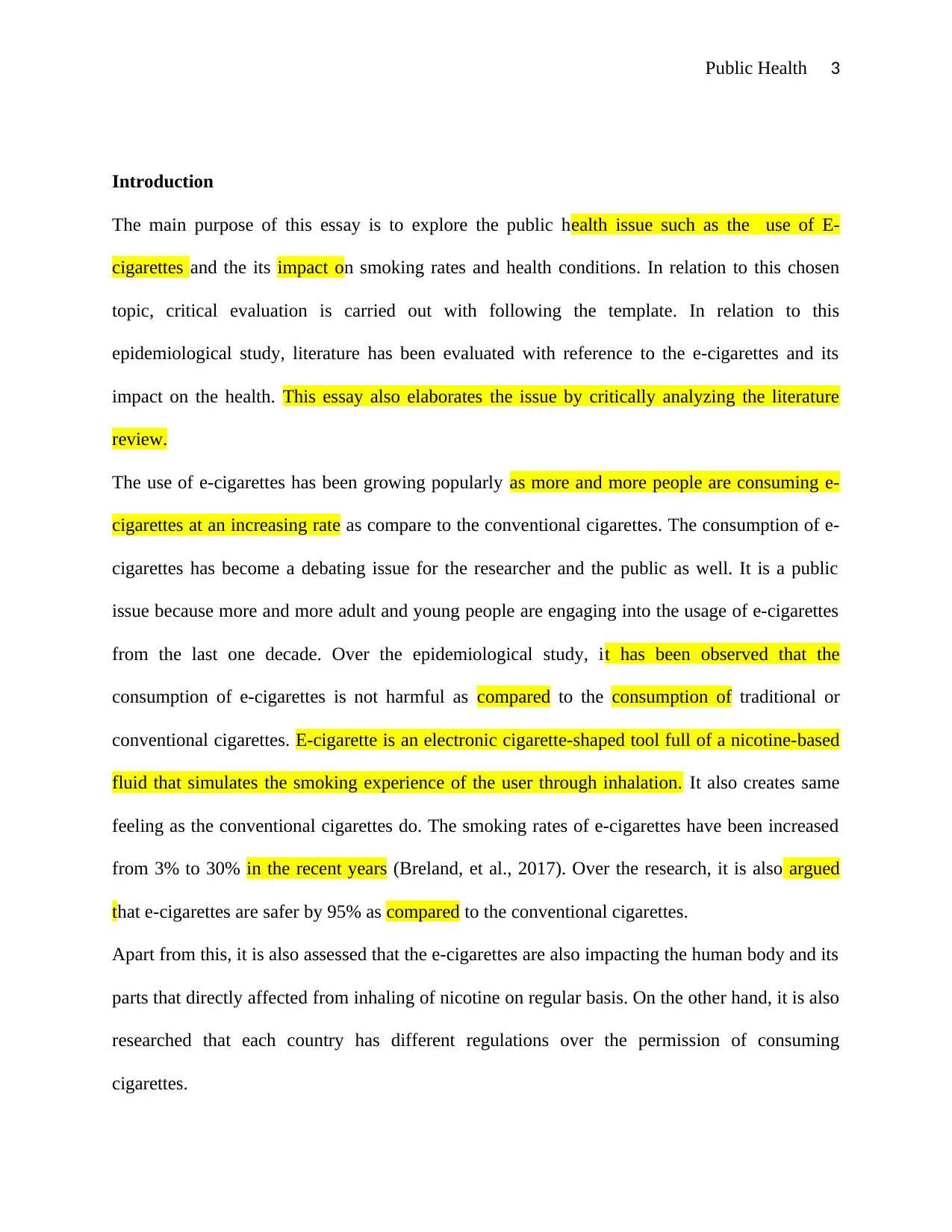
Public Health 3
Introduction
The main purpose of this essay is to explore the public health issue such as the use of E-
cigarettes and the its impact on smoking rates and health conditions. In relation to this chosen
topic, critical evaluation is carried out with following the template. In relation to this
epidemiological study, literature has been evaluated with reference to the e-cigarettes and its
impact on the health. This essay also elaborates the issue by critically analyzing the literature
review.
The use of e-cigarettes has been growing popularly as more and more people are consuming e-
cigarettes at an increasing rate as compare to the conventional cigarettes. The consumption of e-
cigarettes has become a debating issue for the researcher and the public as well. It is a public
issue because more and more adult and young people are engaging into the usage of e-cigarettes
from the last one decade. Over the epidemiological study, it has been observed that the
consumption of e-cigarettes is not harmful as compared to the consumption of traditional or
conventional cigarettes. E-cigarette is an electronic cigarette-shaped tool full of a nicotine-based
fluid that simulates the smoking experience of the user through inhalation. It also creates same
feeling as the conventional cigarettes do. The smoking rates of e-cigarettes have been increased
from 3% to 30% in the recent years (Breland, et al., 2017). Over the research, it is also argued
that e-cigarettes are safer by 95% as compared to the conventional cigarettes.
Apart from this, it is also assessed that the e-cigarettes are also impacting the human body and its
parts that directly affected from inhaling of nicotine on regular basis. On the other hand, it is also
researched that each country has different regulations over the permission of consuming
cigarettes.
Introduction
The main purpose of this essay is to explore the public health issue such as the use of E-
cigarettes and the its impact on smoking rates and health conditions. In relation to this chosen
topic, critical evaluation is carried out with following the template. In relation to this
epidemiological study, literature has been evaluated with reference to the e-cigarettes and its
impact on the health. This essay also elaborates the issue by critically analyzing the literature
review.
The use of e-cigarettes has been growing popularly as more and more people are consuming e-
cigarettes at an increasing rate as compare to the conventional cigarettes. The consumption of e-
cigarettes has become a debating issue for the researcher and the public as well. It is a public
issue because more and more adult and young people are engaging into the usage of e-cigarettes
from the last one decade. Over the epidemiological study, it has been observed that the
consumption of e-cigarettes is not harmful as compared to the consumption of traditional or
conventional cigarettes. E-cigarette is an electronic cigarette-shaped tool full of a nicotine-based
fluid that simulates the smoking experience of the user through inhalation. It also creates same
feeling as the conventional cigarettes do. The smoking rates of e-cigarettes have been increased
from 3% to 30% in the recent years (Breland, et al., 2017). Over the research, it is also argued
that e-cigarettes are safer by 95% as compared to the conventional cigarettes.
Apart from this, it is also assessed that the e-cigarettes are also impacting the human body and its
parts that directly affected from inhaling of nicotine on regular basis. On the other hand, it is also
researched that each country has different regulations over the permission of consuming
cigarettes.
⊘ This is a preview!⊘
Do you want full access?
Subscribe today to unlock all pages.

Trusted by 1+ million students worldwide
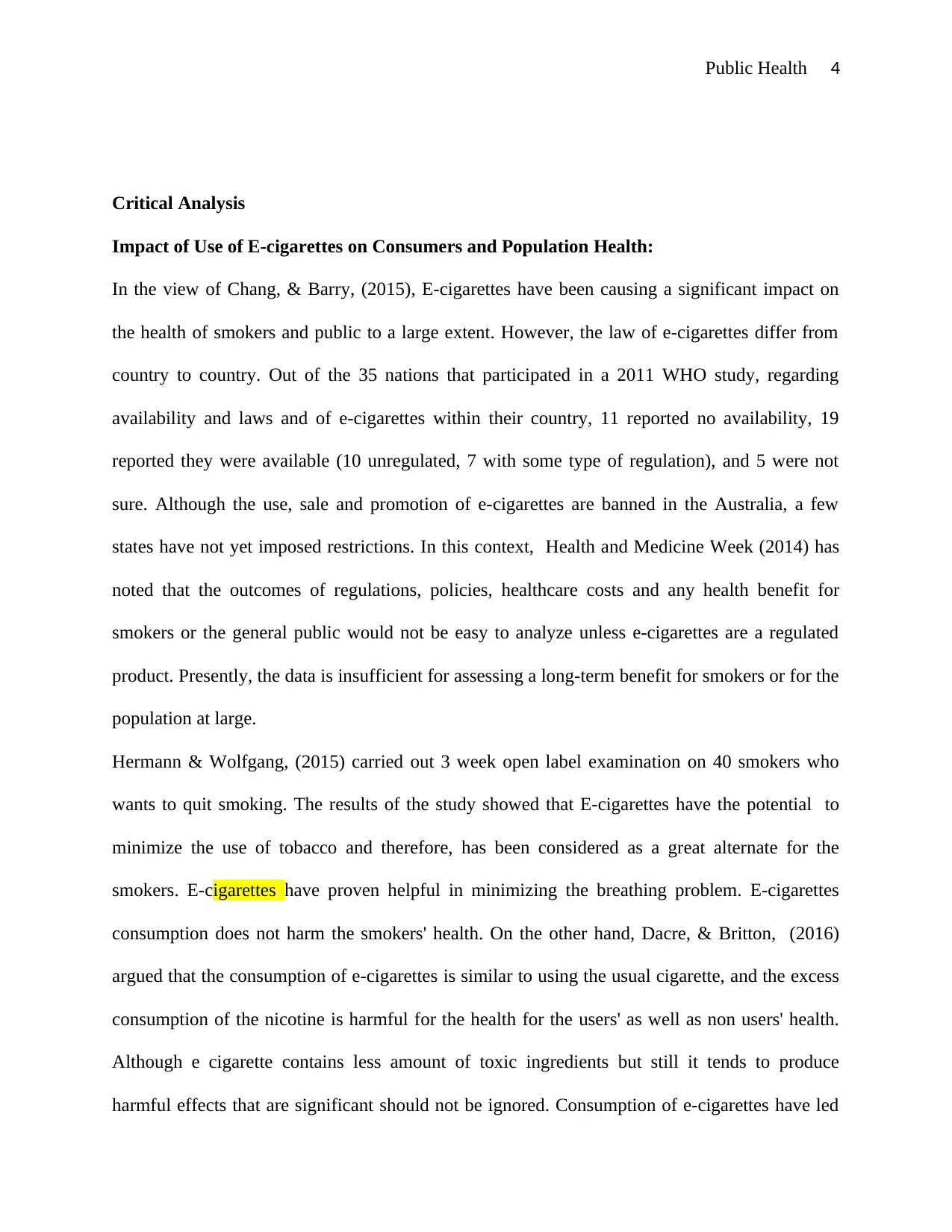
Public Health 4
Critical Analysis
Impact of Use of E-cigarettes on Consumers and Population Health:
In the view of Chang, & Barry, (2015), E-cigarettes have been causing a significant impact on
the health of smokers and public to a large extent. However, the law of e-cigarettes differ from
country to country. Out of the 35 nations that participated in a 2011 WHO study, regarding
availability and laws and of e-cigarettes within their country, 11 reported no availability, 19
reported they were available (10 unregulated, 7 with some type of regulation), and 5 were not
sure. Although the use, sale and promotion of e-cigarettes are banned in the Australia, a few
states have not yet imposed restrictions. In this context, Health and Medicine Week (2014) has
noted that the outcomes of regulations, policies, healthcare costs and any health benefit for
smokers or the general public would not be easy to analyze unless e-cigarettes are a regulated
product. Presently, the data is insufficient for assessing a long-term benefit for smokers or for the
population at large.
Hermann & Wolfgang, (2015) carried out 3 week open label examination on 40 smokers who
wants to quit smoking. The results of the study showed that E-cigarettes have the potential to
minimize the use of tobacco and therefore, has been considered as a great alternate for the
smokers. E-cigarettes have proven helpful in minimizing the breathing problem. E-cigarettes
consumption does not harm the smokers' health. On the other hand, Dacre, & Britton, (2016)
argued that the consumption of e-cigarettes is similar to using the usual cigarette, and the excess
consumption of the nicotine is harmful for the health for the users' as well as non users' health.
Although e cigarette contains less amount of toxic ingredients but still it tends to produce
harmful effects that are significant should not be ignored. Consumption of e-cigarettes have led
Critical Analysis
Impact of Use of E-cigarettes on Consumers and Population Health:
In the view of Chang, & Barry, (2015), E-cigarettes have been causing a significant impact on
the health of smokers and public to a large extent. However, the law of e-cigarettes differ from
country to country. Out of the 35 nations that participated in a 2011 WHO study, regarding
availability and laws and of e-cigarettes within their country, 11 reported no availability, 19
reported they were available (10 unregulated, 7 with some type of regulation), and 5 were not
sure. Although the use, sale and promotion of e-cigarettes are banned in the Australia, a few
states have not yet imposed restrictions. In this context, Health and Medicine Week (2014) has
noted that the outcomes of regulations, policies, healthcare costs and any health benefit for
smokers or the general public would not be easy to analyze unless e-cigarettes are a regulated
product. Presently, the data is insufficient for assessing a long-term benefit for smokers or for the
population at large.
Hermann & Wolfgang, (2015) carried out 3 week open label examination on 40 smokers who
wants to quit smoking. The results of the study showed that E-cigarettes have the potential to
minimize the use of tobacco and therefore, has been considered as a great alternate for the
smokers. E-cigarettes have proven helpful in minimizing the breathing problem. E-cigarettes
consumption does not harm the smokers' health. On the other hand, Dacre, & Britton, (2016)
argued that the consumption of e-cigarettes is similar to using the usual cigarette, and the excess
consumption of the nicotine is harmful for the health for the users' as well as non users' health.
Although e cigarette contains less amount of toxic ingredients but still it tends to produce
harmful effects that are significant should not be ignored. Consumption of e-cigarettes have led
Paraphrase This Document
Need a fresh take? Get an instant paraphrase of this document with our AI Paraphraser
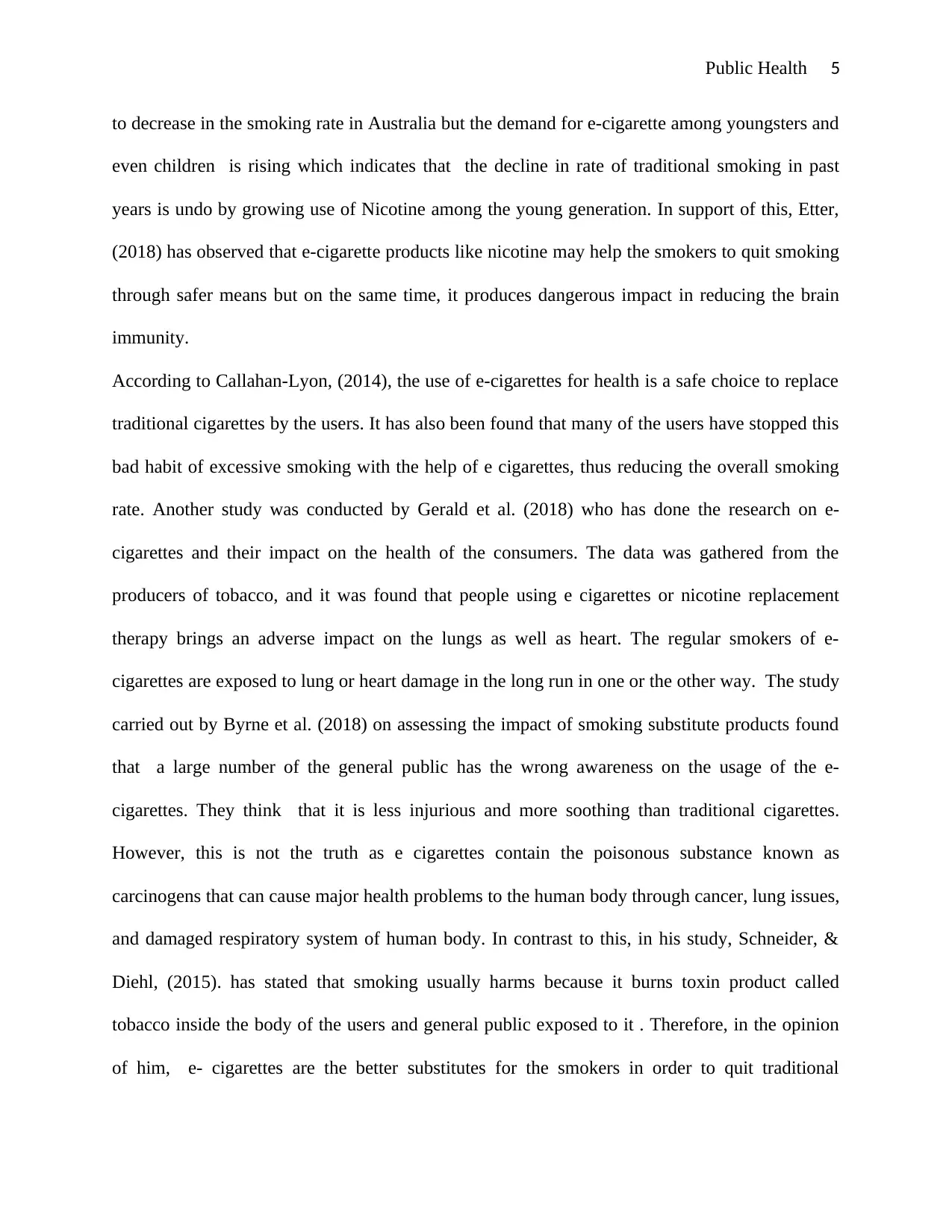
Public Health 5
to decrease in the smoking rate in Australia but the demand for e-cigarette among youngsters and
even children is rising which indicates that the decline in rate of traditional smoking in past
years is undo by growing use of Nicotine among the young generation. In support of this, Etter,
(2018) has observed that e-cigarette products like nicotine may help the smokers to quit smoking
through safer means but on the same time, it produces dangerous impact in reducing the brain
immunity.
According to Callahan-Lyon, (2014), the use of e-cigarettes for health is a safe choice to replace
traditional cigarettes by the users. It has also been found that many of the users have stopped this
bad habit of excessive smoking with the help of e cigarettes, thus reducing the overall smoking
rate. Another study was conducted by Gerald et al. (2018) who has done the research on e-
cigarettes and their impact on the health of the consumers. The data was gathered from the
producers of tobacco, and it was found that people using e cigarettes or nicotine replacement
therapy brings an adverse impact on the lungs as well as heart. The regular smokers of e-
cigarettes are exposed to lung or heart damage in the long run in one or the other way. The study
carried out by Byrne et al. (2018) on assessing the impact of smoking substitute products found
that a large number of the general public has the wrong awareness on the usage of the e-
cigarettes. They think that it is less injurious and more soothing than traditional cigarettes.
However, this is not the truth as e cigarettes contain the poisonous substance known as
carcinogens that can cause major health problems to the human body through cancer, lung issues,
and damaged respiratory system of human body. In contrast to this, in his study, Schneider, &
Diehl, (2015). has stated that smoking usually harms because it burns toxin product called
tobacco inside the body of the users and general public exposed to it . Therefore, in the opinion
of him, e- cigarettes are the better substitutes for the smokers in order to quit traditional
to decrease in the smoking rate in Australia but the demand for e-cigarette among youngsters and
even children is rising which indicates that the decline in rate of traditional smoking in past
years is undo by growing use of Nicotine among the young generation. In support of this, Etter,
(2018) has observed that e-cigarette products like nicotine may help the smokers to quit smoking
through safer means but on the same time, it produces dangerous impact in reducing the brain
immunity.
According to Callahan-Lyon, (2014), the use of e-cigarettes for health is a safe choice to replace
traditional cigarettes by the users. It has also been found that many of the users have stopped this
bad habit of excessive smoking with the help of e cigarettes, thus reducing the overall smoking
rate. Another study was conducted by Gerald et al. (2018) who has done the research on e-
cigarettes and their impact on the health of the consumers. The data was gathered from the
producers of tobacco, and it was found that people using e cigarettes or nicotine replacement
therapy brings an adverse impact on the lungs as well as heart. The regular smokers of e-
cigarettes are exposed to lung or heart damage in the long run in one or the other way. The study
carried out by Byrne et al. (2018) on assessing the impact of smoking substitute products found
that a large number of the general public has the wrong awareness on the usage of the e-
cigarettes. They think that it is less injurious and more soothing than traditional cigarettes.
However, this is not the truth as e cigarettes contain the poisonous substance known as
carcinogens that can cause major health problems to the human body through cancer, lung issues,
and damaged respiratory system of human body. In contrast to this, in his study, Schneider, &
Diehl, (2015). has stated that smoking usually harms because it burns toxin product called
tobacco inside the body of the users and general public exposed to it . Therefore, in the opinion
of him, e- cigarettes are the better substitutes for the smokers in order to quit traditional
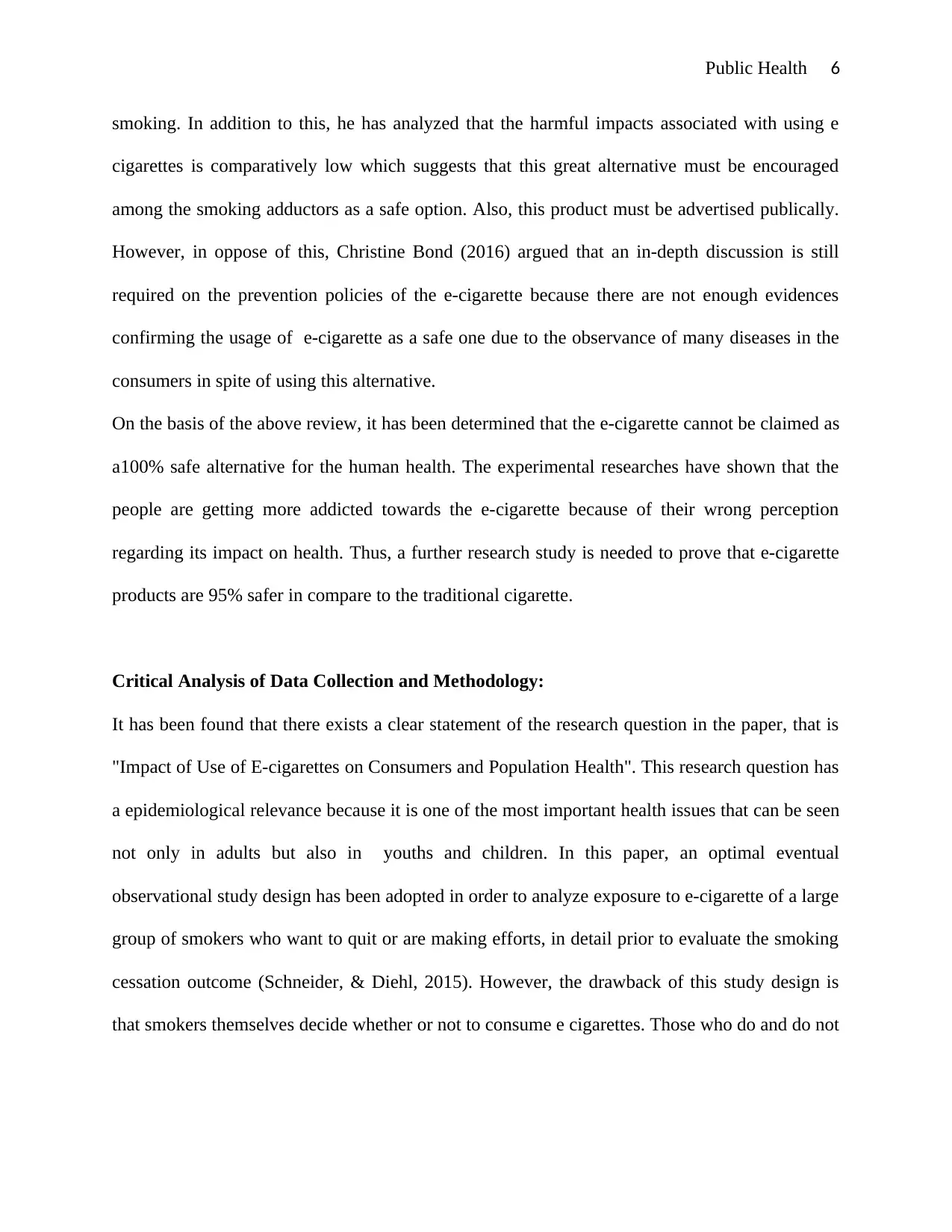
Public Health 6
smoking. In addition to this, he has analyzed that the harmful impacts associated with using e
cigarettes is comparatively low which suggests that this great alternative must be encouraged
among the smoking adductors as a safe option. Also, this product must be advertised publically.
However, in oppose of this, Christine Bond (2016) argued that an in-depth discussion is still
required on the prevention policies of the e-cigarette because there are not enough evidences
confirming the usage of e-cigarette as a safe one due to the observance of many diseases in the
consumers in spite of using this alternative.
On the basis of the above review, it has been determined that the e-cigarette cannot be claimed as
a100% safe alternative for the human health. The experimental researches have shown that the
people are getting more addicted towards the e-cigarette because of their wrong perception
regarding its impact on health. Thus, a further research study is needed to prove that e-cigarette
products are 95% safer in compare to the traditional cigarette.
Critical Analysis of Data Collection and Methodology:
It has been found that there exists a clear statement of the research question in the paper, that is
"Impact of Use of E-cigarettes on Consumers and Population Health". This research question has
a epidemiological relevance because it is one of the most important health issues that can be seen
not only in adults but also in youths and children. In this paper, an optimal eventual
observational study design has been adopted in order to analyze exposure to e-cigarette of a large
group of smokers who want to quit or are making efforts, in detail prior to evaluate the smoking
cessation outcome (Schneider, & Diehl, 2015). However, the drawback of this study design is
that smokers themselves decide whether or not to consume e cigarettes. Those who do and do not
smoking. In addition to this, he has analyzed that the harmful impacts associated with using e
cigarettes is comparatively low which suggests that this great alternative must be encouraged
among the smoking adductors as a safe option. Also, this product must be advertised publically.
However, in oppose of this, Christine Bond (2016) argued that an in-depth discussion is still
required on the prevention policies of the e-cigarette because there are not enough evidences
confirming the usage of e-cigarette as a safe one due to the observance of many diseases in the
consumers in spite of using this alternative.
On the basis of the above review, it has been determined that the e-cigarette cannot be claimed as
a100% safe alternative for the human health. The experimental researches have shown that the
people are getting more addicted towards the e-cigarette because of their wrong perception
regarding its impact on health. Thus, a further research study is needed to prove that e-cigarette
products are 95% safer in compare to the traditional cigarette.
Critical Analysis of Data Collection and Methodology:
It has been found that there exists a clear statement of the research question in the paper, that is
"Impact of Use of E-cigarettes on Consumers and Population Health". This research question has
a epidemiological relevance because it is one of the most important health issues that can be seen
not only in adults but also in youths and children. In this paper, an optimal eventual
observational study design has been adopted in order to analyze exposure to e-cigarette of a large
group of smokers who want to quit or are making efforts, in detail prior to evaluate the smoking
cessation outcome (Schneider, & Diehl, 2015). However, the drawback of this study design is
that smokers themselves decide whether or not to consume e cigarettes. Those who do and do not
⊘ This is a preview!⊘
Do you want full access?
Subscribe today to unlock all pages.

Trusted by 1+ million students worldwide
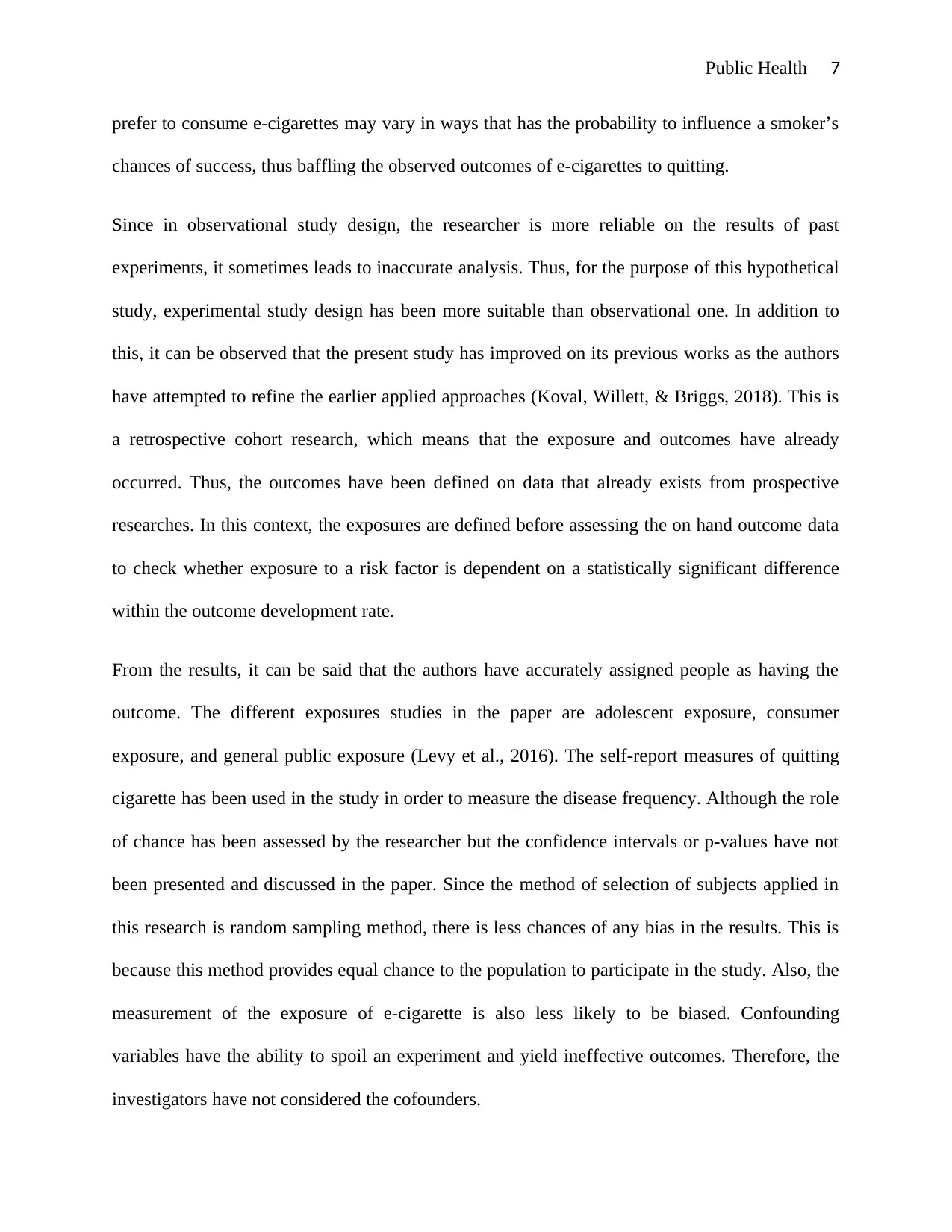
Public Health 7
prefer to consume e-cigarettes may vary in ways that has the probability to influence a smoker’s
chances of success, thus baffling the observed outcomes of e-cigarettes to quitting.
Since in observational study design, the researcher is more reliable on the results of past
experiments, it sometimes leads to inaccurate analysis. Thus, for the purpose of this hypothetical
study, experimental study design has been more suitable than observational one. In addition to
this, it can be observed that the present study has improved on its previous works as the authors
have attempted to refine the earlier applied approaches (Koval, Willett, & Briggs, 2018). This is
a retrospective cohort research, which means that the exposure and outcomes have already
occurred. Thus, the outcomes have been defined on data that already exists from prospective
researches. In this context, the exposures are defined before assessing the on hand outcome data
to check whether exposure to a risk factor is dependent on a statistically significant difference
within the outcome development rate.
From the results, it can be said that the authors have accurately assigned people as having the
outcome. The different exposures studies in the paper are adolescent exposure, consumer
exposure, and general public exposure (Levy et al., 2016). The self-report measures of quitting
cigarette has been used in the study in order to measure the disease frequency. Although the role
of chance has been assessed by the researcher but the confidence intervals or p-values have not
been presented and discussed in the paper. Since the method of selection of subjects applied in
this research is random sampling method, there is less chances of any bias in the results. This is
because this method provides equal chance to the population to participate in the study. Also, the
measurement of the exposure of e-cigarette is also less likely to be biased. Confounding
variables have the ability to spoil an experiment and yield ineffective outcomes. Therefore, the
investigators have not considered the cofounders.
prefer to consume e-cigarettes may vary in ways that has the probability to influence a smoker’s
chances of success, thus baffling the observed outcomes of e-cigarettes to quitting.
Since in observational study design, the researcher is more reliable on the results of past
experiments, it sometimes leads to inaccurate analysis. Thus, for the purpose of this hypothetical
study, experimental study design has been more suitable than observational one. In addition to
this, it can be observed that the present study has improved on its previous works as the authors
have attempted to refine the earlier applied approaches (Koval, Willett, & Briggs, 2018). This is
a retrospective cohort research, which means that the exposure and outcomes have already
occurred. Thus, the outcomes have been defined on data that already exists from prospective
researches. In this context, the exposures are defined before assessing the on hand outcome data
to check whether exposure to a risk factor is dependent on a statistically significant difference
within the outcome development rate.
From the results, it can be said that the authors have accurately assigned people as having the
outcome. The different exposures studies in the paper are adolescent exposure, consumer
exposure, and general public exposure (Levy et al., 2016). The self-report measures of quitting
cigarette has been used in the study in order to measure the disease frequency. Although the role
of chance has been assessed by the researcher but the confidence intervals or p-values have not
been presented and discussed in the paper. Since the method of selection of subjects applied in
this research is random sampling method, there is less chances of any bias in the results. This is
because this method provides equal chance to the population to participate in the study. Also, the
measurement of the exposure of e-cigarette is also less likely to be biased. Confounding
variables have the ability to spoil an experiment and yield ineffective outcomes. Therefore, the
investigators have not considered the cofounders.
Paraphrase This Document
Need a fresh take? Get an instant paraphrase of this document with our AI Paraphraser
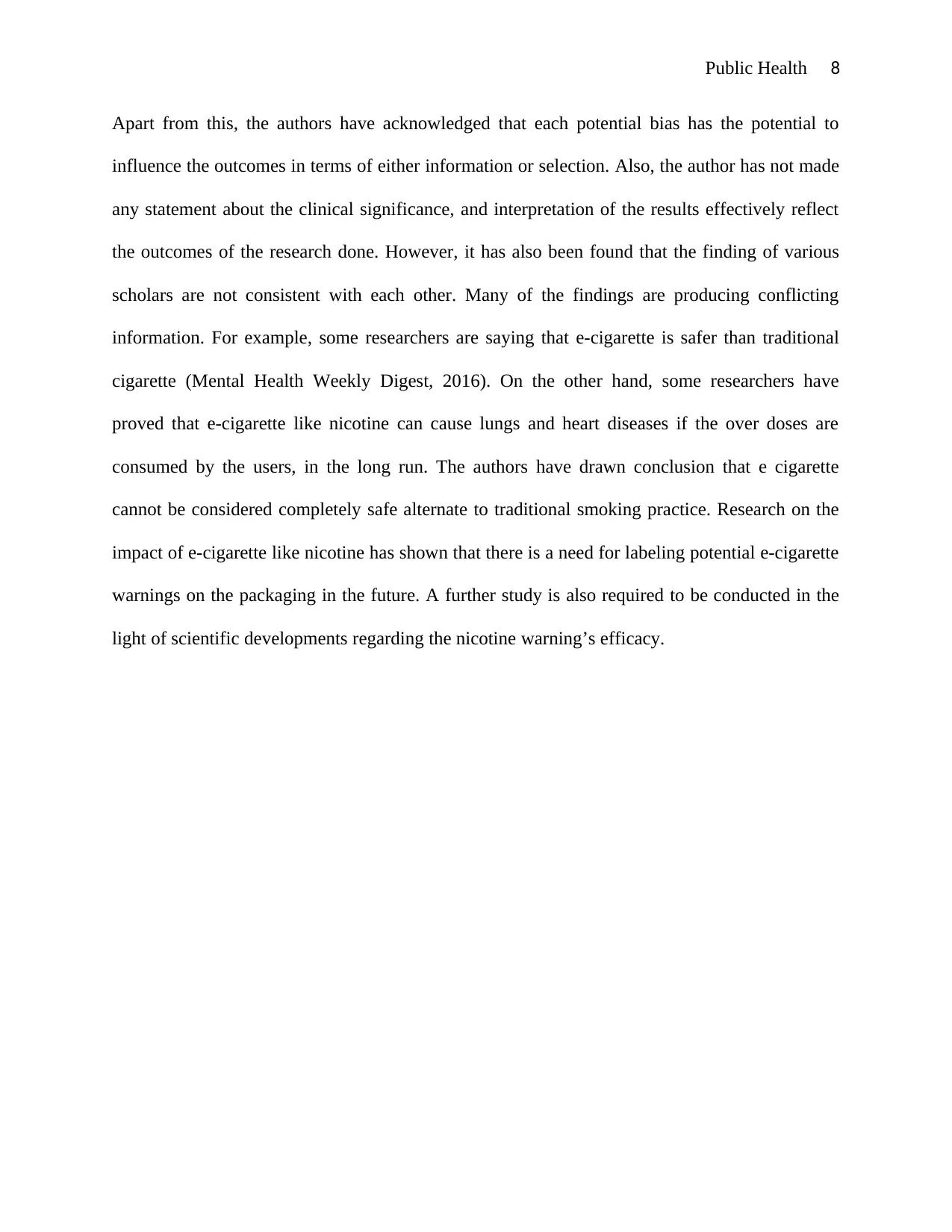
Public Health 8
Apart from this, the authors have acknowledged that each potential bias has the potential to
influence the outcomes in terms of either information or selection. Also, the author has not made
any statement about the clinical significance, and interpretation of the results effectively reflect
the outcomes of the research done. However, it has also been found that the finding of various
scholars are not consistent with each other. Many of the findings are producing conflicting
information. For example, some researchers are saying that e-cigarette is safer than traditional
cigarette (Mental Health Weekly Digest, 2016). On the other hand, some researchers have
proved that e-cigarette like nicotine can cause lungs and heart diseases if the over doses are
consumed by the users, in the long run. The authors have drawn conclusion that e cigarette
cannot be considered completely safe alternate to traditional smoking practice. Research on the
impact of e-cigarette like nicotine has shown that there is a need for labeling potential e-cigarette
warnings on the packaging in the future. A further study is also required to be conducted in the
light of scientific developments regarding the nicotine warning’s efficacy.
Apart from this, the authors have acknowledged that each potential bias has the potential to
influence the outcomes in terms of either information or selection. Also, the author has not made
any statement about the clinical significance, and interpretation of the results effectively reflect
the outcomes of the research done. However, it has also been found that the finding of various
scholars are not consistent with each other. Many of the findings are producing conflicting
information. For example, some researchers are saying that e-cigarette is safer than traditional
cigarette (Mental Health Weekly Digest, 2016). On the other hand, some researchers have
proved that e-cigarette like nicotine can cause lungs and heart diseases if the over doses are
consumed by the users, in the long run. The authors have drawn conclusion that e cigarette
cannot be considered completely safe alternate to traditional smoking practice. Research on the
impact of e-cigarette like nicotine has shown that there is a need for labeling potential e-cigarette
warnings on the packaging in the future. A further study is also required to be conducted in the
light of scientific developments regarding the nicotine warning’s efficacy.
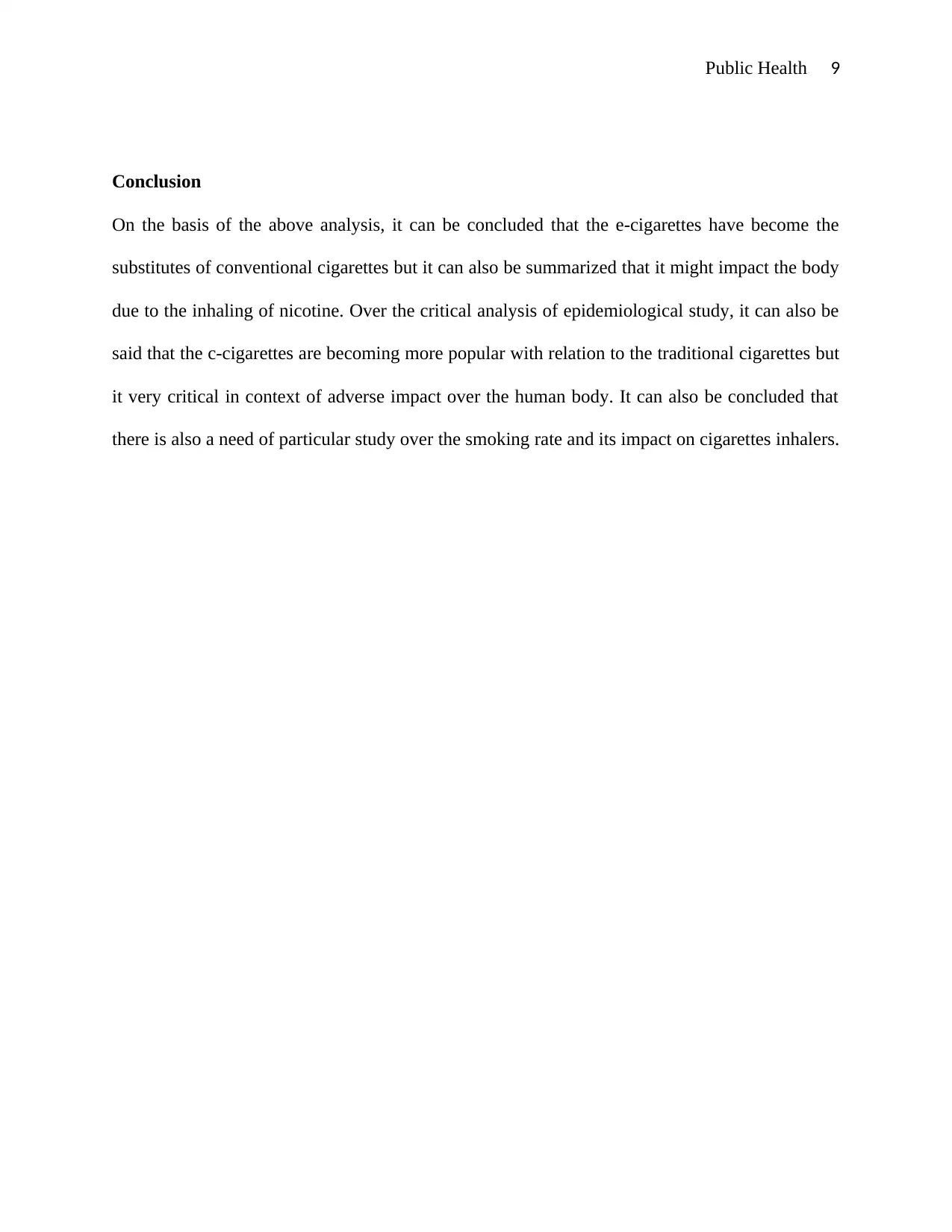
Public Health 9
Conclusion
On the basis of the above analysis, it can be concluded that the e-cigarettes have become the
substitutes of conventional cigarettes but it can also be summarized that it might impact the body
due to the inhaling of nicotine. Over the critical analysis of epidemiological study, it can also be
said that the c-cigarettes are becoming more popular with relation to the traditional cigarettes but
it very critical in context of adverse impact over the human body. It can also be concluded that
there is also a need of particular study over the smoking rate and its impact on cigarettes inhalers.
Conclusion
On the basis of the above analysis, it can be concluded that the e-cigarettes have become the
substitutes of conventional cigarettes but it can also be summarized that it might impact the body
due to the inhaling of nicotine. Over the critical analysis of epidemiological study, it can also be
said that the c-cigarettes are becoming more popular with relation to the traditional cigarettes but
it very critical in context of adverse impact over the human body. It can also be concluded that
there is also a need of particular study over the smoking rate and its impact on cigarettes inhalers.
⊘ This is a preview!⊘
Do you want full access?
Subscribe today to unlock all pages.

Trusted by 1+ million students worldwide
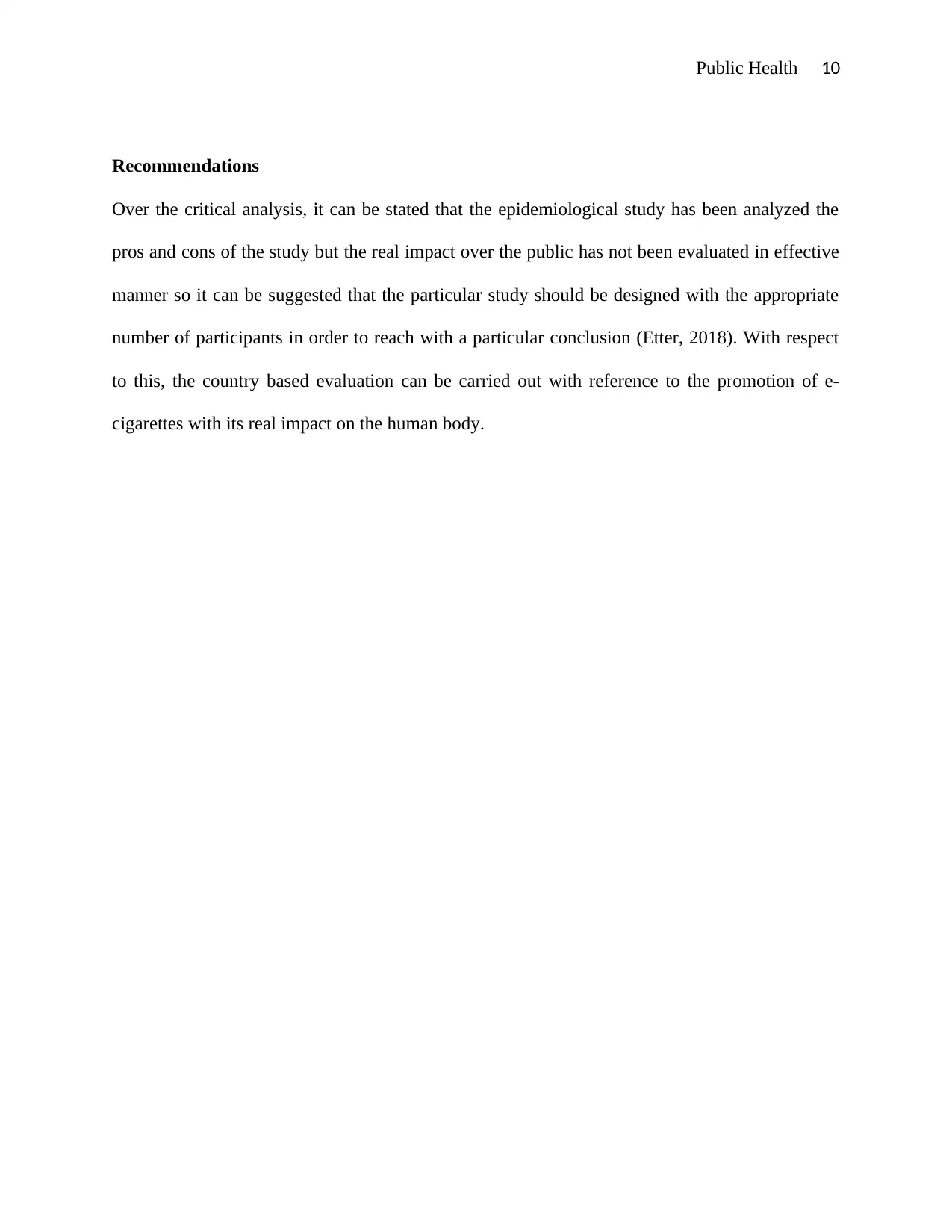
Public Health 10
Recommendations
Over the critical analysis, it can be stated that the epidemiological study has been analyzed the
pros and cons of the study but the real impact over the public has not been evaluated in effective
manner so it can be suggested that the particular study should be designed with the appropriate
number of participants in order to reach with a particular conclusion (Etter, 2018). With respect
to this, the country based evaluation can be carried out with reference to the promotion of e-
cigarettes with its real impact on the human body.
Recommendations
Over the critical analysis, it can be stated that the epidemiological study has been analyzed the
pros and cons of the study but the real impact over the public has not been evaluated in effective
manner so it can be suggested that the particular study should be designed with the appropriate
number of participants in order to reach with a particular conclusion (Etter, 2018). With respect
to this, the country based evaluation can be carried out with reference to the promotion of e-
cigarettes with its real impact on the human body.
Paraphrase This Document
Need a fresh take? Get an instant paraphrase of this document with our AI Paraphraser
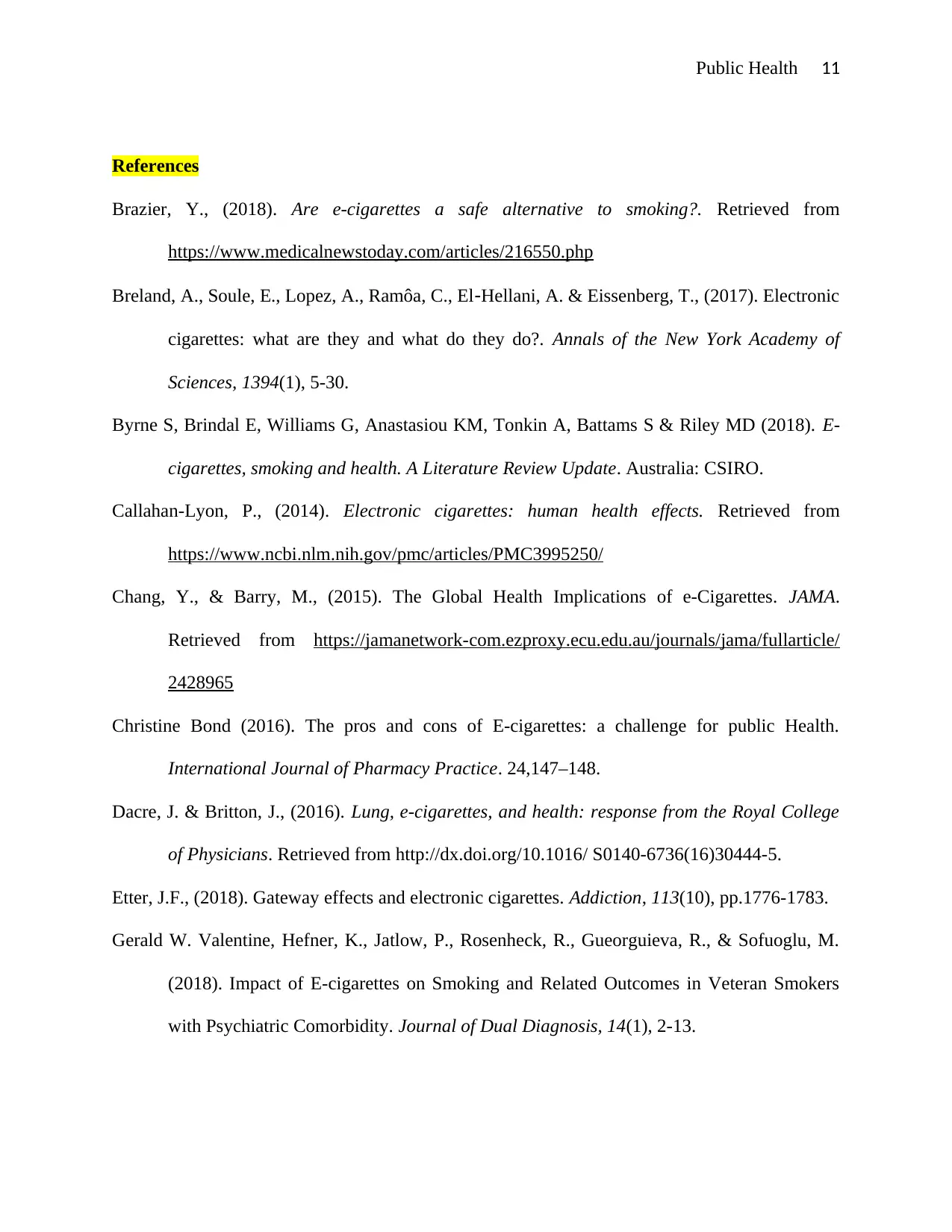
Public Health 11
References
Brazier, Y., (2018). Are e-cigarettes a safe alternative to smoking?. Retrieved from
https://www.medicalnewstoday.com/articles/216550.php
Breland, A., Soule, E., Lopez, A., Ramôa, C., El‐Hellani, A. & Eissenberg, T., (2017). Electronic
cigarettes: what are they and what do they do?. Annals of the New York Academy of
Sciences, 1394(1), 5-30.
Byrne S, Brindal E, Williams G, Anastasiou KM, Tonkin A, Battams S & Riley MD (2018). E-
cigarettes, smoking and health. A Literature Review Update. Australia: CSIRO.
Callahan-Lyon, P., (2014). Electronic cigarettes: human health effects. Retrieved from
https://www.ncbi.nlm.nih.gov/pmc/articles/PMC3995250/
Chang, Y., & Barry, M., (2015). The Global Health Implications of e-Cigarettes. JAMA.
Retrieved from https://jamanetwork-com.ezproxy.ecu.edu.au/journals/jama/fullarticle/
2428965
Christine Bond (2016). The pros and cons of E-cigarettes: a challenge for public Health.
International Journal of Pharmacy Practice. 24,147–148.
Dacre, J. & Britton, J., (2016). Lung, e-cigarettes, and health: response from the Royal College
of Physicians. Retrieved from http://dx.doi.org/10.1016/ S0140-6736(16)30444-5.
Etter, J.F., (2018). Gateway effects and electronic cigarettes. Addiction, 113(10), pp.1776-1783.
Gerald W. Valentine, Hefner, K., Jatlow, P., Rosenheck, R., Gueorguieva, R., & Sofuoglu, M.
(2018). Impact of E-cigarettes on Smoking and Related Outcomes in Veteran Smokers
with Psychiatric Comorbidity. Journal of Dual Diagnosis, 14(1), 2-13.
References
Brazier, Y., (2018). Are e-cigarettes a safe alternative to smoking?. Retrieved from
https://www.medicalnewstoday.com/articles/216550.php
Breland, A., Soule, E., Lopez, A., Ramôa, C., El‐Hellani, A. & Eissenberg, T., (2017). Electronic
cigarettes: what are they and what do they do?. Annals of the New York Academy of
Sciences, 1394(1), 5-30.
Byrne S, Brindal E, Williams G, Anastasiou KM, Tonkin A, Battams S & Riley MD (2018). E-
cigarettes, smoking and health. A Literature Review Update. Australia: CSIRO.
Callahan-Lyon, P., (2014). Electronic cigarettes: human health effects. Retrieved from
https://www.ncbi.nlm.nih.gov/pmc/articles/PMC3995250/
Chang, Y., & Barry, M., (2015). The Global Health Implications of e-Cigarettes. JAMA.
Retrieved from https://jamanetwork-com.ezproxy.ecu.edu.au/journals/jama/fullarticle/
2428965
Christine Bond (2016). The pros and cons of E-cigarettes: a challenge for public Health.
International Journal of Pharmacy Practice. 24,147–148.
Dacre, J. & Britton, J., (2016). Lung, e-cigarettes, and health: response from the Royal College
of Physicians. Retrieved from http://dx.doi.org/10.1016/ S0140-6736(16)30444-5.
Etter, J.F., (2018). Gateway effects and electronic cigarettes. Addiction, 113(10), pp.1776-1783.
Gerald W. Valentine, Hefner, K., Jatlow, P., Rosenheck, R., Gueorguieva, R., & Sofuoglu, M.
(2018). Impact of E-cigarettes on Smoking and Related Outcomes in Veteran Smokers
with Psychiatric Comorbidity. Journal of Dual Diagnosis, 14(1), 2-13.
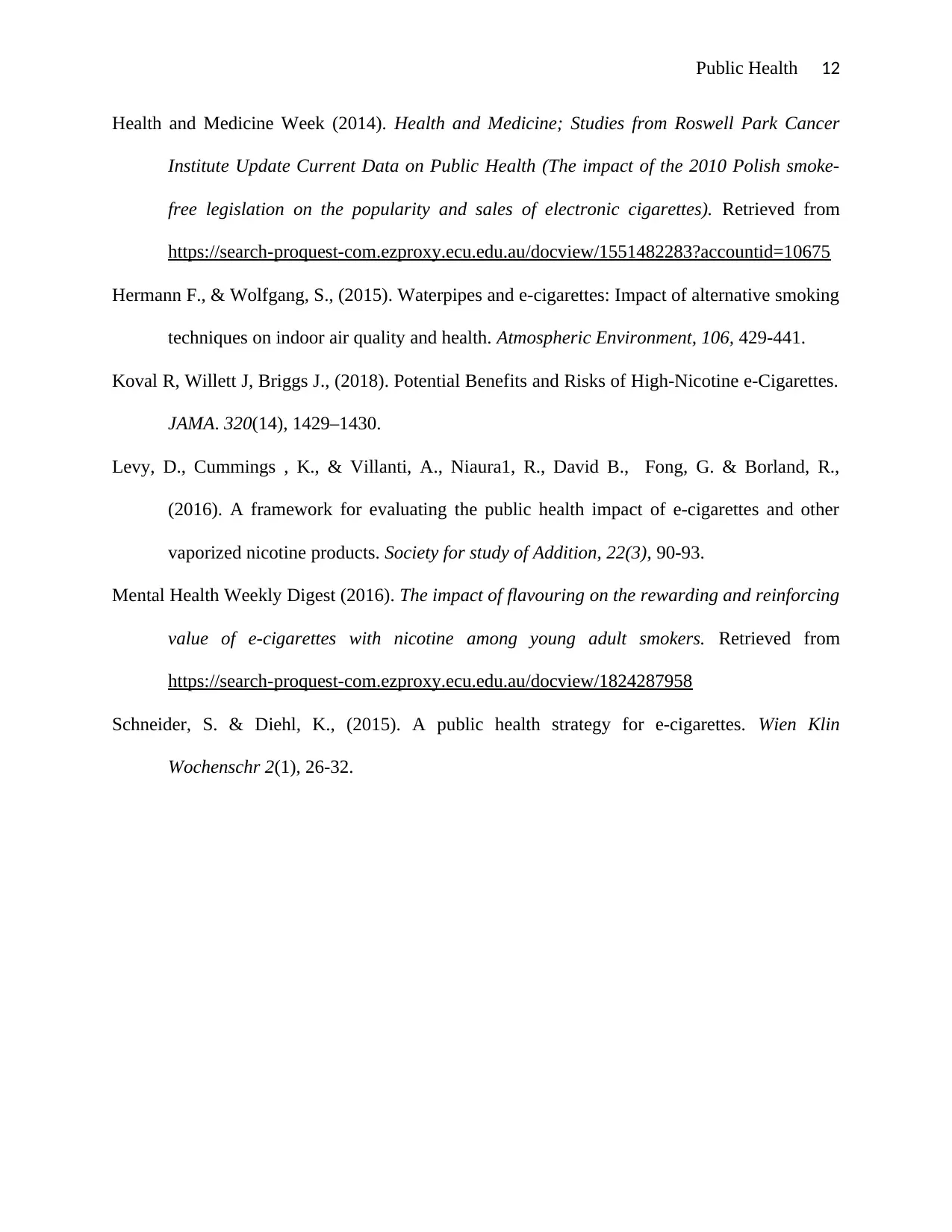
Public Health 12
Health and Medicine Week (2014). Health and Medicine; Studies from Roswell Park Cancer
Institute Update Current Data on Public Health (The impact of the 2010 Polish smoke-
free legislation on the popularity and sales of electronic cigarettes). Retrieved from
https://search-proquest-com.ezproxy.ecu.edu.au/docview/1551482283?accountid=10675
Hermann F., & Wolfgang, S., (2015). Waterpipes and e-cigarettes: Impact of alternative smoking
techniques on indoor air quality and health. Atmospheric Environment, 106, 429-441.
Koval R, Willett J, Briggs J., (2018). Potential Benefits and Risks of High-Nicotine e-Cigarettes.
JAMA. 320(14), 1429–1430.
Levy, D., Cummings , K., & Villanti, A., Niaura1, R., David B., Fong, G. & Borland, R.,
(2016). A framework for evaluating the public health impact of e-cigarettes and other
vaporized nicotine products. Society for study of Addition, 22(3), 90-93.
Mental Health Weekly Digest (2016). The impact of flavouring on the rewarding and reinforcing
value of e-cigarettes with nicotine among young adult smokers. Retrieved from
https://search-proquest-com.ezproxy.ecu.edu.au/docview/1824287958
Schneider, S. & Diehl, K., (2015). A public health strategy for e-cigarettes. Wien Klin
Wochenschr 2(1), 26-32.
Health and Medicine Week (2014). Health and Medicine; Studies from Roswell Park Cancer
Institute Update Current Data on Public Health (The impact of the 2010 Polish smoke-
free legislation on the popularity and sales of electronic cigarettes). Retrieved from
https://search-proquest-com.ezproxy.ecu.edu.au/docview/1551482283?accountid=10675
Hermann F., & Wolfgang, S., (2015). Waterpipes and e-cigarettes: Impact of alternative smoking
techniques on indoor air quality and health. Atmospheric Environment, 106, 429-441.
Koval R, Willett J, Briggs J., (2018). Potential Benefits and Risks of High-Nicotine e-Cigarettes.
JAMA. 320(14), 1429–1430.
Levy, D., Cummings , K., & Villanti, A., Niaura1, R., David B., Fong, G. & Borland, R.,
(2016). A framework for evaluating the public health impact of e-cigarettes and other
vaporized nicotine products. Society for study of Addition, 22(3), 90-93.
Mental Health Weekly Digest (2016). The impact of flavouring on the rewarding and reinforcing
value of e-cigarettes with nicotine among young adult smokers. Retrieved from
https://search-proquest-com.ezproxy.ecu.edu.au/docview/1824287958
Schneider, S. & Diehl, K., (2015). A public health strategy for e-cigarettes. Wien Klin
Wochenschr 2(1), 26-32.
⊘ This is a preview!⊘
Do you want full access?
Subscribe today to unlock all pages.

Trusted by 1+ million students worldwide
1 out of 12
Related Documents
Your All-in-One AI-Powered Toolkit for Academic Success.
+13062052269
info@desklib.com
Available 24*7 on WhatsApp / Email
![[object Object]](/_next/static/media/star-bottom.7253800d.svg)
Unlock your academic potential
Copyright © 2020–2025 A2Z Services. All Rights Reserved. Developed and managed by ZUCOL.




